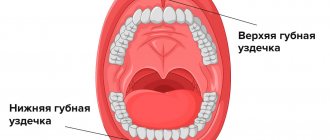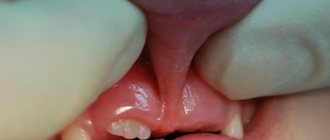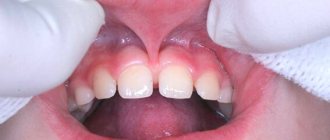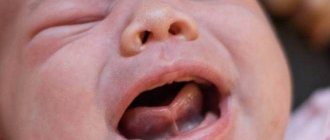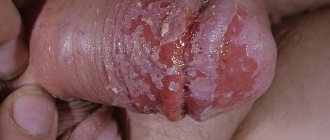In our clinic, plastic surgery of the frenulum of the tongue and lip is performed by highly qualified pediatric dental surgeons. Anesthesia is performed step by step, both local using an application gel followed by the injection of an anesthetic, and under general anesthesia - mask anesthesia.
Frenumplasty is a simple and effective operation with virtually no complications. After the operation, the child feels well and pain is minimal.
The hyoid frenulum is an elastic membrane that connects the tongue to the oral cavity. Thanks to its presence, we are able to control the mobility of the tongue, regulate breathing, speech, and eat food. This strip of tissue normally originates from the inner middle of the tongue, continuing along the mucosa and ending near the base of the gums of the central incisors of the lower jaw. It is approximately 3 cm long.
Ankyloglossia or shortened frenulum of the tongue is a diagnosis that parents of children can often hear from pediatric dentists. What is this pathological condition? The upper end of the frenulum in this case is not located in the middle, but at the tip of the tongue or a little closer.
By lifting the tip of the tongue, you can see it in the form of a groove, which often bifurcates. If you stick your tongue out, its tip bends down and slightly covers the lower lip. This fold fixes the tongue in the wrong position, which limits its mobility. This type of bridle is called short. As a result of such a defect, the development of the lower jaw may be delayed, general discomfort may arise, and malocclusion and speech disorders may develop.
Causes of the defect
The anomaly occurs during intrauterine development. The provoking factors of a short frenulum of the tongue are:
- fetal infection;
- viral diseases that occur during the first and last trimester of pregnancy;
- genetic predisposition, heredity;
- unfavorable environmental background;
- abdominal injuries of a pregnant woman;
- chronic somatic diseases of the expectant mother.
The decisive factor is heredity. It was noted that among parents who personally encountered a similar pathology, their children often also needed frenulum correction.
Diagnostic methods
How can a tongue tie be diagnosed in infants? Parents can easily recognize this defect on their own. The baby’s tongue is tightly attached to the lower jaw, its movements are limited (mobility directly depends on the severity of the anomaly), the child is not able to stick his tongue out of his mouth. By lifting the baby's tongue, you can see the connective tissue thread that attaches the tongue to the oral cavity.
This diagnosis can be easily recognized during breastfeeding. For such babies, the feeding process takes a longer time, since the baby is not able to grasp the nipple normally. Therefore, the sucking process is difficult and intermittent. Because of this, these babies gain weight slowly and become restless before feeding.
In older children, such a pathology as a short frenulum is expressed by a violation of word formation and a lisp - it is difficult for them to pronounce the sounds sh, shch, h, zh, r.
Signs of an abnormal (shortened) frenulum
A normal frenulum of the tongue in a newborn should be about 8 mm long. By the age of five, its length can increase to 17-18 mm.
Signs of a lack of frenulum length in infants:
- feeding lasts longer than usual and occurs with short stops;
- the baby is capricious when feeding;
- the child arches, throws back his head;
- underweight;
- the baby bites the breast and “clicks” when feeding;
- The baby may refuse to breastfeed.
Signs of a short frenulum of the tongue in older children and adult patients:
- malocclusion;
- frequently recurring periodontitis;
- problematic fixation of prostheses;
- difficulties in pronouncing many sounds;
- periodontal diseases.
A shortened frenulum is also indicated by:
- lower incisors directed inward;
- bifurcation of the tip of the tongue and its deepening when trying to stretch it;
- inability to reach the tip of the tongue to the sky or lick your lips;
- the tongue is uneven, its lower end is pressed, and its rear end is raised;
- have difficulty swallowing solid food;
- heart-shaped tongue in an elevated position;
- the tongue bends as it moves forward.
If a shortened frenulum of the tongue is detected, its correction is required. And the sooner this is done, the better.
There are different types of tongue frenulum anomalies:
- thin transparent (because of it the tongue functions poorly, but the child does not feel discomfort);
- translucent, with a bifurcating ending when the tongue moves;
- thick, attached to the lower palate and noticeably limiting its mobility;
- short, fused with the muscles of the tongue;
- unexpressed, difficult to notice due to complete fusion with the muscles (the tongue moves with difficulty, swallowing food is difficult and speech disorders are observed).
In each case, the doctor determines the degree of shortening of the frenulum and the method of treating the anomaly.
Treatment of a short frenulum of the tongue
In children, treatment of a short frenulum is carried out surgically. Excision of the frenulum is a simple operation with virtually no complications. After this procedure, the child feels well and does not experience any pain.
The decision on the need to trim the frenulum (frenotomy) is made immediately as soon as the baby is born, since bloodless plastic surgery cannot affect the general condition of the newborn. The procedure can be performed directly in the maternity hospital or in the dental office. Babies have few blood vessels and nerve endings, so the doctor does not use anesthesia when making a transverse incision. If there is slight bleeding, it can be easily stopped by applying the baby to the chest. After the operation, the newborn adapts to the new conditions for several days, so the mother will immediately feel the difference during feeding.
If the short frenulum is not corrected in time, the child may develop other developmental pathologies a few years later, such as incorrect dentition, speech defects, etc. If you ignore plastic surgery until the child is 5-6 years old, there may be a need for real surgical intervention, in which Sutures are placed and anesthesia is administered. Trimming the frenulum is carried out with special scissors or a radio wave scalpel. The duration of the procedure is no more than a minute.
Children of primary school age are brought to the surgical office by an orthodontist or speech therapist when the consequences of an untreated short frenulum are too obvious. During the operation, the tongue is released. Separately, uneven teeth and incorrect pronunciation have to be corrected.
In the event that it was not possible to perform plastic surgery in childhood, and a short frenulum of the tongue as a person grows older causes severe discomfort and significantly limits the excursion of the tongue, it is necessary to visit a dentist. The doctor will recommend an operation that can relieve the patient of speech defects and periodontal inflammation in the area of the lower incisors. In both adult patients and adolescents, the operation is performed under general anesthesia, using self-absorbing sutures.
Features of sound production in children with a short frenulum
In the process of carrying out exercises and massage to stretch the hyoid frenulum, certain sounds are made:
- Sounds like [ch], [l], [sch], [d], [t] should be started when the frenulum has not yet fully stretched.
- The sounds [р], [ш], [ж] - these letters can be taught to children to pronounce after the frenulum is fully stretched. All other sounds are pronounced by the child without complications.
While performing all the exercises, remember that they need to be performed:
- regularly;
- with maximum efficiency;
- gradually increasing the time and amount of exercise.
As soon as you notice that your child’s pronunciation of sounds is incorrect or he cannot reach the palate with his tongue, you should immediately begin to perform the exercises described above. The sooner you start classes, the faster and easier it will be to achieve results. Stretching the frenulum is an unpleasant and even slightly painful procedure for the child. There is no need to expect great results after two or three days of training; you should be patient and gradually move towards your goal.
Frenuloplasty
Frenuloplasty is a surgical method for treating the complete form of ankyloglossia. It is performed on children who are already 5 years old, since they are already able to understand the essence of the procedure, as well as on adult patients. There are 3 options for performing the operation:
- Removal - during the operation, a significant part of the frenulum is clamped with instruments, incisions are made from below and above in the shape of a triangle, and the edges of the wound are sutured.
- Cutting is the easiest method for this pathology. The fold is cut, and its side edges are pulled together using transverse seams, while grasping the fabric at great depth.
- Moving the attachment point. In this case, 2 incisions are first made, which separate a strip of tissue between the interdental papillae and the transitional fold. The edges are brought together using suture material, and the cut strip is then sewn to the area of the wound that remains.
Exercise is a good alternative to surgery
If parents are willing to put in a lot of effort and spend a lot of time, then treatment for a short frenulum of the tongue can be carried out using gymnastics. Classes with the child should be regular, several times a day, and the number of approaches and repetitions should be gradually increased.
Basic exercises to stretch the frenulum:
- tongue movements with half-opened lips along the upper lip;
- protruding the tongue to its maximum length and returning it back;
- licking a saucer (or imitating this action);
- touch the tip of your nose with your tongue, then your chin and your nose again.
After treatment for a short frenulum, the patient visits a speech therapist and gets acquainted with special exercises that help stretch the muscles and folds of the tongue. In some cases, facial massage is performed. If angiloglossia is treated in a timely manner, there will be no consequences for the full development and health of the child.
A set of exercises for stretching the hyoid ligament card file on speech therapy on the topic
SET OF STRETCHING EXERCISES
HYPOGLOUS LIGAMENT
Even if the frenulum is shortened (less than 8 mm), it is better to stretch it than to operate. This is supported by the fact that after the operation there will be a scar on the frenulum, which will also reduce its mobility. In addition, the operated child will be afraid to do articulation exercises for the hypoglossal ligament for a long time in order to avoid the previously experienced pain.
The short frenulum of the tongue is stretched to the required length using special exercises. If it is very short, it may take quite some time to stretch it.
Normally, the length of the frenulum is 1.5 cm. If the frenulum is shortened, the movements of the tongue are limited. Consequently, the pronunciation of sounds that require raising the tongue upward is impaired.
Rules for making sounds with a short frenulum
- Sounds that require a noticeable upward movement of the tip of the tongue (r, w, g) are placed after the child’s hyoid ligament is fully stretched.
- Sounds (l, h, sch, th, d) can be started when the frenulum has not yet fully stretched, but there is already some upward movement of the tip of the tongue.
- A short frenulum does not interfere with the normal pronunciation of other sounds of the Russian language.
Rules for performing exercises
- When performing exercises, the mouth should be opened as wide as possible, but at the same time so that the child can reach the alveoli with the tip of the tongue.
- All movements should be performed slowly, with a smile, close to the limit of what is possible.
- It should be borne in mind that performing exercises is physically difficult for a child, the tongue may get tired, the hyoid ligament may hurt - give him rest.
Exercise "Painter"
Smile, open your mouth. Using the wide tip of your tongue, stroke the palate from the teeth to the throat. The lower jaw should not move.
It's time to paint the rooms.
A painter was hired.
We lower the jaw lower,
We help the painter.
Exercise "Horse"
Smile, open your mouth. Click the tip of your tongue like a horse clicking. The mouth is open, the tip of the tongue is not extended or pointed. Make sure that it does not tuck inward and that the lower jaw remains motionless.
We're riding, we're riding a horse along a smooth path. A neighbor invited us to visit for sweet pudding. We arrived at lunchtime, but the neighbor was not at home.
Exercise "Mushroom"
Smile, open your mouth. Suck your wide tongue to the roof of your mouth. This is the cap of the mushroom, and the hyoid ligament is the stalk. The tip of the tongue should not turn up, the lips should be in a smile. If the child is unable to suck his tongue, then he can click his tongue, as in the “Horse” exercise. Clicking trains the desired movement of the tongue.
I stand on a thin leg,
I stand on a smooth leg,
Under the brown hat
With velvet lining.
Exercise "Accordion"
Position the tongue as in the “Mushroom” exercise, lips in a smile. Without lifting your tongue, open and close your mouth.
I play the harmonica, I open my mouth wider, I press my tongue to the roof of my mouth, I move my jaw lower.
Exercise "Drum"
Smile, open your mouth. Repeatedly and clearly pronounce the sound D – D – D. When pronouncing this sound, the tongue rests on the upper teeth, do not close the mouth. Very often, when performing this exercise, the child closes his mouth. To prevent this from happening, you can hold a stick about 1 cm wide or the handle of a rectangular children's toothbrush between your teeth (the handle should not be thick, it should be straight, like a ruler).
We beat the drum hard
And all together we sing:
“D—d—d—d!”
Exercise "Swing"
Smile, open your mouth. On the count of “one-two”, alternately rest your tongue on the upper and lower teeth. The lower jaw is motionless.
I swing on a swing
Up and down, up and down.
I rise higher and higher, and then down.
Exercise “Reach your nose”
Smile, open your mouth. Raise the wide tip of the tongue towards the nose and lower it towards the upper lip. Make sure that the tongue does not narrow and that the lips and lower jaw are not mobile.
Our tongue is great,
Reaches to the nose...
Exercise "Football"
Close your mouth, press the tip of your tongue against one cheek, then the other, so that balls are inflated under the cheek.
Do you want to play?
We drive the ball into the goal.
Exercise "Kitten"
Put a little condensed milk, sour cream, jam on a saucer... and lick it off with your tongue like a kitten. You can lick the ice cream with your tongue.
We poured it into a bowl
Milk for pussy.
The cat laps -
The tongue flickers.
Exercise “Self-massage”
Do the mushroom exercise. The child rubs the frenulum himself with his thumb and forefinger.
Here is a fungus on a thin stalk -
You put it in the basket!
Exercise "Mole"
Use your index fingers and thumbs to pull your tongue down by the tip.
There is a slide in the yard.
Use your index fingers and thumbs to pull your tongue upward by the tip.
There is a mink under the hill.
With your index finger, forcefully stroke the hyoid frenulum from bottom to top, stretching it.
In this hole.
The mole is guarding the mink.
Literature:
- Arkhipova E. F. Speech therapy massage for dysarthria. – M.:AST: Astrel; Vladimir: VKT, 2008
- Krause E. N. Speech therapy. (Speech therapy classes with children of early and young age) - St. Petersburg: KARO, 2005.
- Kosinova E. M. Speech therapist lessons - M.: EKSMO, 2003.
- Novikovskaya O. A. Speech gymnastics. – M.: AST; St. Petersburg Owl; Vladimir: VKT, 2008
- Polyakova M. A. Self-instruction manual on speech therapy. Universal guide. – M.: Iris-press, 2007.
general information
Frenuloplasty is a simple and fairly effective operation that involves cutting the frenulum of the upper lip. It allows you to prevent or solve many problems related to the child’s health. Sometimes this operation is also performed on adults (if an orthodontist or speech therapist recommends it).
The labial frenulums are elastic folds of the oral mucosa that provide support for the lips in the correct position and attach them to the jaw bones and gums. The size of the frenulum and its location are very individual: there are people who have several frenulums, while others do not have any at all. This pathology can provoke malocclusion and periodontal disease. In the case of its normal location, the frenulum of the upper lip is woven into the gum (5-8 mm in the middle of the neck of the tooth), it does not interfere with normal speech, and also does not negatively affect health. When the upper frenulum is woven into the interdental papilla (if it is very short, wide or not elastic enough), various negative consequences are possible. This defect can be corrected by plastic surgery of the frenulum of the upper lip. There are no other methods that will restore health and make a normal frenulum.
Who undergoes upper lip frenuloplasty?
Most dental patients who undergo this type of surgery are children, since a thick or short frenulum can cause various serious complications:
- The presence of a diastema (gap) between the central incisors. Weaving into the interdental papilla, the frenulum of the upper lip forms a thick cord that prevents the possibility of convergence towards the center of the incisors. The diastema increases with constant load, and teeth shift from the center and forward. In this case, constant trauma to the interdental papilla occurs, which contributes to the development of periodontitis and tooth loss.
- In preparation for treatment with an orthodontist. Various soft tissue cords in the oral cavity, including the frenulum of the tongue and upper lip, can create a slight load on the dentition, and this has a significant impact on the bite. If you need to correct your bite, be sure to pay attention to the frenulum in the mouth.
- For periodontal diseases and the threat of their development. In this situation, the frenulum of the upper lip pulls the mucous membrane from the teeth. Gum recession develops - an unpleasant phenomenon that requires expensive and lengthy treatment.
- In preparation for removable prosthetics. A short frenulum of the tongue when moving the lips (for example, when eating or talking) can contribute to the removal of removable dentures. This is true for those patients who use them.
- In some cases, a severely shortened frenulum can provoke speech therapy problems by disrupting sound production. Therefore, in this case, plastic surgery of the upper lip is also indicated.
- In infants - difficulty sucking the breast, increased duration of feeding, insufficient weight gain.
- The occurrence of malocclusion ─ with a shortened frenulum, the front incisors move forward. Therefore, if surgery is not performed in time, subsequent treatment will be expensive and difficult.
- A gradual increase in tooth instability, exposure of their roots and increased sensitivity.
- The formation of a gum pocket is a depression between the gum and tooth, which ultimately leads to plaque and periodontitis.
Optimal age for upper frenulum correction
How urgently such an operation needs to be performed depends on the severity of the pathology and its strength of influence on the child’s health. For children, there are two favorable periods for plastic surgery of the upper frenulum. One of them is the age of 2.5-6 months, which will simplify the problem of feeding because the child will not lose the nipple, which happens with a short frenulum. In the old days, such an operation was not performed at such an early age, but with the advent of new techniques and modern medical equipment, such an intervention is now quite safe, and infants tolerate it well. This operation should only be performed by a pediatric dentist-surgeon.
The second favorable period for frenulum correction is the age of 6-9 years. At this age, four front incisors have already erupted on the lower and upper dental arches. There is an active change in the bite - baby teeth fall out and permanent teeth erupt. It is ideal when the central incisors are erupting and there are no lateral incisors yet. In such a situation, the lateral incisors, which are erupting, push the central ones towards the center (now nothing can interfere with their movement). And then everything will return to normal - on its own or with orthodontic support.
Due to certain physiological differences, plastic surgery of the lower lip is performed at the age of 7-9 years, of the upper lip - at 6-8 years. If pediatricians overlooked the pathology in childhood, the need for plastic surgery of the upper lip frenulum also arises in adulthood. There is no danger in this, since adults can undergo such an operation just as easily as children.
Types of treatment
Dentists distinguish 5 types of shortening of the frenulum of the tongue. Grade 1 is considered the easiest, and grade 5 is the most difficult. The optimal treatment method can only be advised by a specialist, who is important to contact early.
Often, a doctor prescribes plastic surgery for the frenulum of the tongue, but many parents do not want this. However, there are indications in which this particular method will bring the most positive results. These indications are:
For infants, the main indication for surgery is feeding disorders, when the baby has difficulty sucking the breast, screams and does not gain weight.
If the frenulum was not corrected promptly and promptly, then after a year in 90% of cases it is possible to correct this pathology using non-surgical methods. However, there are cases when it is still impossible to do without surgery.
Indications for surgical treatment of pathology
The fact that this type of frenulum shortening requires surgical treatment is usually decided by the main specialists: an orthopedist, a surgeon and a speech therapist. Typically, for this type of treatment there should be indications:
- inability to eat normally;
- tooth displacement;
- malocclusion;
- serious speech therapy pathologies that cannot be treated conservatively.
In preschool children, this pathology is usually diagnosed by a speech therapist. It often occurs with dyslalia, when it is difficult to pronounce hissing, whistling or palatal sounds.
Orthopedic disorders can also be associated with frenuloplasty: delayed development of the lower jaw and subsequent inward inclination of the incisors.
In adulthood, excessive attachment of the lingual frenulum does not allow secure fastening of orthodontic structures. Therefore, before prosthetics, it is necessary to first perform plastic surgery of the frenulum of the tongue. This is important because with this pathology, dentures often come off when talking or chewing food.
It is especially important to identify shortening of the frenulum and perform its plastic surgery before installing implants, since ankyloglossia often contributes to re-implantitis, when the nutrition of the tissues around the implant is disrupted. Because of this, the implant loses its support and subsequently falls out.
Also, ankyloglossia in adults can be the cause of such periodontal diseases as the appearance of pockets in the jaw, pathological dental mobility, exposure of tooth roots (gum recession), etc.
Main types of operations for ankyloglossia
Depending on the type of pathology, patients with ankyloglossia may be offered several types of corrective surgeries for frenuloplasty:
- Frenulotomy. This is the simplest operation in which the frenulum is cut and then the edges of the mucous membrane are sutured.
- Frenulectomy (Glickman method). With this method, the fixed frenulum is incised from the side of the teeth, and its edges are sutured.
- Frenuloplasty (Vinogradova method). With this method, a triangle-shaped flap is cut from the mucosa, which is then sutured to the mucosa.
- Other types of frenuloplasty are the Popovich and Limberg methods. Each method has its own indications for surgery.
Laser treatment
Laser plastic surgery of the lingual frenulum is a microsurgical procedure and has a minimum of complications
Laser correction lasts 3-5 minutes, no stitches are needed after it. Instead, a bandage with healing-accelerating drugs is applied to the wound (keratoplasty).
The laser works non-contact and as accurately as possible. The most important advantages of them are:
- comfort for the patient;
- no bleeding after surgery;
- minimal pain during surgery;
- minimum bacterial complications and infection;
- filigree and precision of cuts;
- minimum doses of anesthetics;
- ergonomics;
- no seams;
- the postoperative period does not exceed 2 days;
- speed of healing of postoperative sutures.
Laser surgery is as safe and comfortable as possible, which is especially important when treating children.
Indications for surgery
Some pediatricians believe that a short frenulum of the upper lip is not an indication for emergency plastic surgery. But the indications for surgical intervention on the labial frenulum are determined not by a pediatrician or a dental surgeon, but by specialists of narrower profiles - a neonatologist, periodontist, orthodontist or speech therapist.
Often, a neonatologist pays attention to a problem with the frenulum in a newborn if this anomaly affects proper breastfeeding, because the baby’s upper lip is actively involved in this process. In this case, the doctor very often trims the frenulum of the upper lip on his own or may refer the child to a pediatric dentist-surgeon.
A short frenulum of the upper lip can be noticed by speech therapists if the baby’s clear speech functions are impaired and it is difficult to pronounce certain sounds that require the active participation of the lips, for example, “u”, “o” and others. Most often this happens in children after the age of five. In such a situation, conventional cutting is not enough; the patient needs a more complex operation.
Periodontologists and orthodontists most often refer children or adult patients for plastic surgery of the upper lip of a child or adult patient, since an incorrectly attached lip frenulum creates numerous negative consequences for the dental bite and periodontium. If plastic surgery of the upper lip frenulum is not carried out in a timely manner, this may lead to the need for lengthy and expensive orthodontic treatment in the future.
How is the operation performed?
Preparation for such a surgical intervention comes down to thorough sanitation of the oral cavity, because any infection in it can provoke complications. It is necessary to undergo an examination to ensure that there are no contraindications to such an intervention.
This operation does not require special preparation, since the procedure is low-traumatic. Before performing it, doctors advise patients to be full, because such an intervention is less tolerated on an empty stomach, and hunger is an additional stress, which causes the blood to clot more slowly.
One of the important conditions for performing an operation in childhood is to ensure that the little patient sits quietly in a chair for at least 10-15 minutes. The procedure does not cause discomfort and is absolutely painless; during the procedure, the baby can sit with his mouth slightly open, and is even able to talk.
Plastic surgery of the frenulum is carried out in several stages:
- frenotomy – the frenulum of the upper lip is dissected;
- frenectomy – excision of the frenulum of the upper lip is performed;
- frenuloplasty – the place where the frenulum is woven is moved to a new depth.
The operation is performed using two methods. Its classic version uses a scalpel. A more modern method is laser surgery. However, despite all the advantages of laser correction, the classical method remains relevant, which is used in our clinic. This is especially true for complex clinical cases, in which the skill of the surgeon is very important. Upper lip plastic surgery is performed on an outpatient basis. The duration of the classic operation is no more than a quarter of an hour, and local anesthesia (injections or gel) is used.
If you retract the lip with a narrow frenulum of the upper lip, it is possible to see a transparent film that is not attached to the edge of the alveolar process. It is cut transversely, then longitudinal sutures are applied.
In the case of a wide frenulum of the upper lip, the doctor makes an incision in the tense frenulum along the ridge, excises the interdental papilla and the tissues of the bone space located between the roots of the central incisors.
How does the procedure work?
Bridle cutting in Perovo is performed on patients of all ages. In children older than 9 months, the procedure is performed with scissors using local anesthesia. Older children are shown plastic surgery, which is performed by excision of a thin fold of the upper lip and changing the location of its attachment with sutures.
Surgical manipulation will be performed using the following methods:
- Classic cutting involves the use of a regular scalpel. After surgery, the incision is sutured. Rehabilitation continues for several days.
- Delete. At the top and bottom of the thin fold, cuts are made in the form of a triangle. The remaining part of the membrane is clamped with medical instruments. After its removal, a wound appears, which is stitched with a self-absorbing thread.
- Moving the attachment point. Two incisions are made on the frenulum, isolating the tissue strip between the transition line and the interdental papilla. In order to reduce the distance between the edges of the cut, stitches are applied. The separated strip is sutured to the wound area.
- Laser surgery is performed using a laser scalpel. It is absolutely painless, and the rehabilitation period will take only 2 days. An important advantage of this method is the absence of bleeding and rapid postoperative recovery.
Postoperative period
The rehabilitation period also goes smoothly. There is no doubt that some pain may occur at the surgical site when the effects of the pain medications wear off.
In the postoperative period, you need to adhere to the following golden rules:
- carefully carry out oral hygiene;
- the first two days after the intervention, do not eat hot and rough foods (nuts, carrots, apples, etc.);
- one day after the operation, visit the surgeon for a follow-up examination.
The sutures in the classical method of operation are not removed, because surgeons use catgut - a suture material that is characterized by self-resorption. The patient may experience minor discomfort at first as he adapts to the ability to move his tongue more freely, but his speech improves very quickly. After a few days, you can perform myogymnastics ─ special exercises that help strengthen the facial and chewing muscles. Children love to make faces, and a dose of positive emotions won’t hurt adults either. By fulfilling all these conditions, the child will not encounter any complications in the postoperative period. In addition, such an operation goes almost unnoticed, and the results obtained will prevent many problems in the future.
Implantation: rules of care after surgery
Dental implantation is another type of surgical intervention, after which careful care of teeth and gums is required. Even if the most modern medical equipment was used during the operation and the implants consist of the latest materials, the patient needs to know a number of standard recommendations.
Care immediately after dental implantation
After the operation, begin applying ice to the cheek on which the intervention took place. This can be done several times with a break of twenty minutes. It is enough to hold the ice on your cheek for seven to ten minutes.
After the dental implantation procedure, you can wipe the wounded area with a cotton swab soaked in water and salt. You can add just a little iodine to the water. If you are bleeding heavily, apply a sterile gauze pad to the wound for twenty minutes. Remember that bleeding after implantation, as well as after tooth extraction, is normal if it does not last too long.
If you experience pain, you can use painkillers prescribed by your doctor, but not earlier than an hour and a half after the operation.
Care for several days after implantation
When you brush your teeth, in the first few days try not to touch the sore spot with the bristles. To treat the implant, use water with a little salt dissolved in it. In food, exclude the consumption of hard fruits, tea, coffee, carbonated sweet and mineral waters, alcoholic beverages, and hot food. This ban lasts two to three days, the ban on eating hot food lasts for a day.





